#duke friedrich wilhelm of Mecklenburg-Schwerin
Explore tagged Tumblr posts
Text

Duke Friedrich Wilhelm Victor August Ernst of Prussia and Duchess Cecilie Auguste Marie of Mecklenburg-Schwerin, last Crown Prince and Princess of Prussia
German vintage postcard
#marie#schwerin#briefkaart#vintage#ernst#german#crown#postcard#postkaart#prussia#sepia#princess#carte postale#crown prince#postal#cecilie auguste marie#wilhelm#mecklenburg-schwerin#duchess#photo#auguste#victor#mecklenburg#ansichtskarte#ephemera#duke#cecilie#historic#friedrich wilhelm victor#prince
4 notes
·
View notes
Text

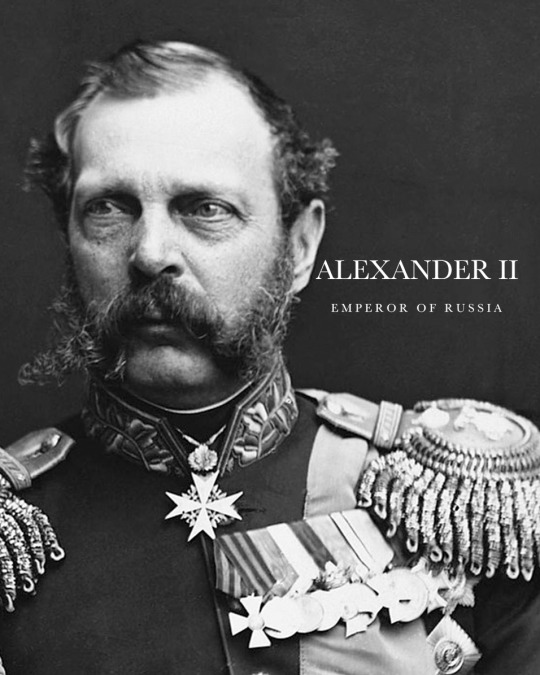
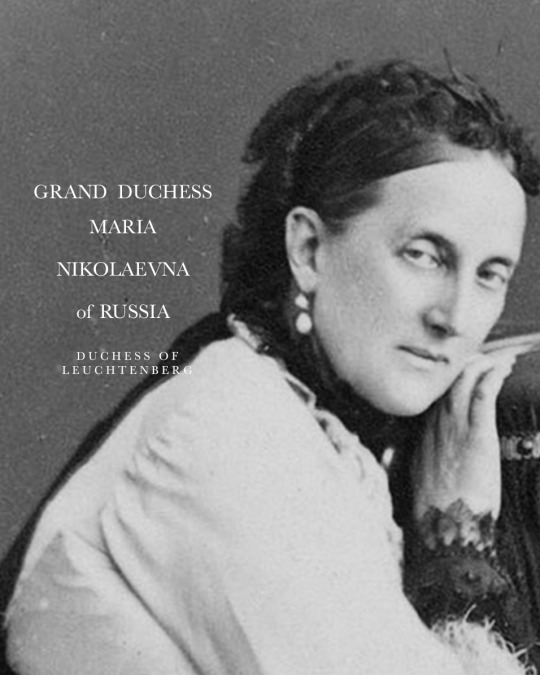
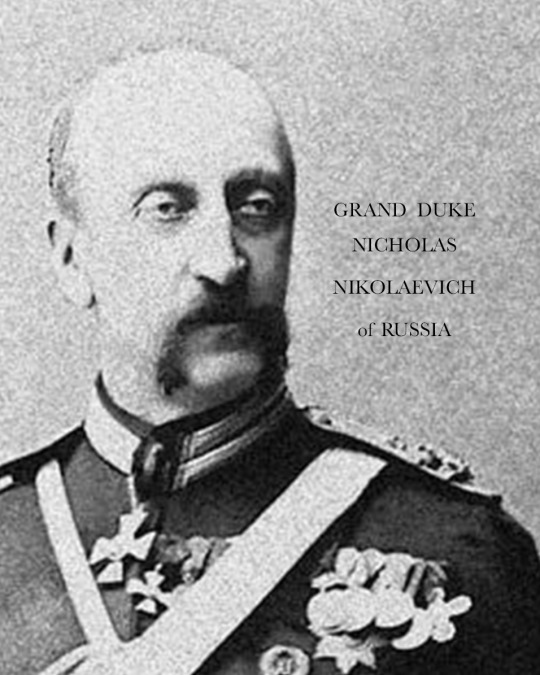

GODPARENTS OF GRAND DUKE ALEXEI MIKHAILOVICH
Grand Duke Alexei Mikhailovich was born on 28 December 1875 in Tbilisi, Tbilisi Governate, Russian Empire (now Georgia). He was the the sixth son and youngest child of Grand Duke Michael Nikolaevich of Russia, himself the youngest son of Emperor Nicholas I. He was the only Grand Duke to bear the name and patronymic of a Tsar: Alexei Mikhailovich. On 11 January (New Style) 1876, he was christened at Tbilisi by the Palace Priest and Confessor of Their Imperial Highnesses. He had seven godparents, as listed:
ALEXANDER II, EMPEROR OF RUSSIA - his uncle, the Russian Emperor stood as one of the godparents. He became the Emperor of All Russia in 1855. Alexander’s most significant reform as emperor was the emancipation of Russia’s serfs in 1861, for which he is known as Alexander the Liberator.
GRAND DUCHESS MARIA PAVLOVNA OF RUSSIA, GRAND DUCHESS CONSORT OF SAXE-WEIMAR-EISENACH - his aunt was one of his godparents. One of the daughters of Emperor Paul I, the grand duchess married a German prince Karl Friedrich, Grand Duke of Saxe-Weimar-Eisenach in 1804. She was an intellect, interested in both arts and sciences. German poet and novelist Johann Wolfgang von Goethe hailed her as one of the worthiest women of his time. She was the great-grandmother of Wilhelm II, German Emperor and Queen Victoria of Sweden.
GRAND DUKE NICHOLAS MIKHAILOVICH OF RUSSIA - his uncle, was one of his godparents. Trained for the military, as a Field Marshal he commanded the Russian army of the Danube in the Russo-Turkish War, 1877–1878.
GRAND DUCHESS MARIA PAVLOVNA OF RUSSIA - known as 'Maria Pavlovna the Elder', was the wife of his first cousin Grand Duke Vladimir Alexandrovich, and stood as one of his godparents. Born as Duchess Marie of Mecklenburg-Schwerin, her ancestors included Emperor Paul I of Russia. Upon her marriage to the grand duke, she became a prominent hostess in Saint Petersburg.
GRAND DUKE ALEXEI ALEXANDROVICH OF RUSSIA - his first cousin and namesake, one of the sons of Emperor Alexander II, was one of his godparents. Chosen for a naval career, Alexei Alexandrovich started his military training at an early age. By the age of 20 he had been appointed lieutenant of the Imperial Russian Navy, eventually becoming general-admiral.
GRAND DUCHESS ANASTASIA MIKHAILOVNA OF RUSSIA, GRAND DUCHESS OF MECKLENBURG-SCHWERIN - his sister, was one of his godparents. In 1879, when Alexei Mikhailovich was only four years-old, his only sister married a German prince, Friedrich Franz III of Mecklenburg-Schwerin (the elder brother of Grand Duchess Maria Pavlovna the Elder). Their children included Queen Alexandrine of Denmark and Crown Princess Cecile of Prussia. She was a strong-willed, independent and unconventional woman. She never became used to her new country where she was unpopular.
GRAND DUKE MICHAEL MIKHAILOVICH OF RUSSIA - one of his older brothers stood as another of his godparents. As Romanov tradition demanded, he followed a military career. He served in the Russo-Turkish War in 1877, became a Colonel and was adjutant at the Imperial court. In 1891 he contracted a morganatic marriage with Countess Sophie von Merenberg, a morganatic daughter of Prince Nicholas William of Nassau and a granddaughter of the Russian poet Alexander Pushkin. For contracting this marriage without permission, their first cousin Emperor Alexander III stripped him of his military titles and banished the couple from the Russian Empire. Alexei Mikhailovich never saw his brother again after his banishment.
Source
#alexei mikhailovich#romanovs#history#alexander ii#maria pavlovna the younger#maria nikolaevna#nicholas nikolaevich#alexei alexandrovich#anastasia mikhailovna#michael mikhailovich#godparents
25 notes
·
View notes
Text
what: queen's tiaras
(All italicised text in this post is made up for the sake of this story)
THE ALEXANDRA FABERGÉ TIARA

Shown worn by Alexandra, Grand Duchess of Mecklenburg-Schwerin (nee Princess of Hannover and Cumberland). Alexandra is a granddaughter of Christian IX of Denmark and was a first cousin to Christian X of Denmark, Haakon VII of Norway (and his wife Maud of Wales), Nicholas II of Russia, George V of the United Kingdom and Constantine I of Greece. Alexandra married Friedrich Franz IV, Grand Duke of Mecklenburg-Schwerin in 1904. They had five children. Alexandra is the great-grandmother of the current monarch, Karolina Augusta I.

Named for its first owner, the Alexandra Fabergé Tiara was created by Fabergé in 1904 as a wedding present from her new husband, Friedrich Franz. It is made of diamonds and aquamarines, with forget-me-nots, bows and Cupid arrows worked into the design.

The tiara was inherited by her eldest surviving daughter, Thyra, upon Alexandra’s death in 1963. The tiara then passed to Thyra’s eldest son, Wilhelm Franz I, it was inherited by his daughter upon his death in 1992.
The tiara is generally reserved for use by the monarch or the monarch’s spouse. Since 2006, Karolina Augusta has been the only person to wear the tiara. She wears it with regularly frequency (once or twice a year).
THE ALEXANDRA FRINGE TIARA

Shown above worn by Alexandra, Grand Duchess of Mecklenburg-Schwerin (nee Princess of Hannover and Cumberland).
Named for its first owner, The Alexandra Fringe Tiara was created for Alexandra in the popular fringe style that imitated Russian Kokoshniks. The tiara was gifted to Alexandra following her marriage to Friedrich Franz IV, Grand Duke of Mecklenburg-Schwerin in 1904.
Alexandra gave the tiara to her eldest surviving daughter, Thyra, in 1945.
The tiara is made of upright rows of diamonds. While the tiara is generally reserved for the monarch and the monarch’s spouse, it is the traditional bridal tiara of the descendants of Thyra, Queen of Mecklenburg. The tiara is regularly worn by the current monarch and her mother, but continues to be lent to members of the family for weddings.
THE ALEXANDRA SCROLL TIARA

Alexandra received this tiara in 1904 as a wedding gift from her parents The Crown Prince and Princess of Hannover. The tiara is made of diamond scroll patterns and creates a circlet (it goes all the way around in a circle).
The tiara is generally reserved for use by the monarch or the monarch’s spouse. Presently, the tiara is only worn by Eleonora, the mother of the current monarch. Karolina Augusta I has chosen not to wear the tiara as of yet.
THE AMALIE AMETHYST TIARA

The Amalie Amethyst Tiara is made of pear-shaped amethysts in a fringe design and is named for its original own, Duchess Amalie in Bavaria. The tiara was inherited by her second daughter, Karola of Urach. The tiara is accompanied by a pair of drop earrings. Duchess Amalie in Bavaria is the great-great-grandmother of the current monarch, Karolina Augusta I.

The Amalie Amethyst Tiara is generally reserved for the monarch or the monarch’s spouse. Since 2006, Karolina Augusta, who is a big fan of amethysts, has been the only person to wear the tiara.
THE AMALIE FLORAL TIARA

The Amalie Floral Tiara is made of diamonds and is named for its original owner, Duchess Amalie in Bavaria. The tiara was inherited by her second daughter, Karola of Urach. Karola had the tiara refashioned to be worn as a bandeau across the forehead. The tiara has not been refitted to be worn atop the head, but is instead normally nestled amongst the hair or still worn across the forehead. Duchess Amalie in Bavaria is the great-great-grandmother of the current monarch, Karolina Augusta I.
The Amalie Floral Tiara is generally reserved for the monarch or the monarch’s spouse. Presently, the tiara is worn by the current monarch and her mother, although its setting means the tiara is not worn often.
THE ELISABETH PEARL TIARA

Shown above worn by Elisabeth, Duchess of Mecklenburg-Schwerin (nee Princess of Stolberg-Rossla). The Elisabeth Pearl Tiara is named for its original owner. Elisabeth was the second wife of Duke Johann Albrecht of Mecklenburg-Schwerin, they were married in 1909. Elisabeth was the stepmother of Heinrich Ludwig I of Mecklenburg. After the death of her husband in 1920, Elisabeth married his younger half-brother, Adolf Friedrich. Elisabeth died in 1969.
The Elisabeth Pearl Tiara is made of diamonds and pearls. The tiara was inherited by Elisabeth’s step-grandson upon her death. This tiara is generally reserved for the monarch or the monarch’s spouse, and is currently worn by Karolina Augusta I and her mother, Eleonora.
THE ELISABETH SYBILLE GARRARD & CO TIARA

The Elisabeth Sybille Garrard & Co Tiara was purchased for Elisabeth Sybille, Duchess of Mecklenburg-Schwerin (nee Princess of Saxe-Weimar-Eisenach) from the British jewellery house by her husband, Duke Johann Albrecht of Mecklenburg-Schwerin during his tenure as regent for the Duchy of Brunswick. The tiara was created by Garrard & Co in the 1880s and is made of diamonds and upright and suspended pearls.
The Elisabeth Sybille Garrard & Co Tiara was inherited by her son, Heinrich Ludwig I, eventually being inherited by the current monarch, Karolina Augusta I. The tiara is typically reserved for the monarch or the monarch’s spouse, and is a popular choice for Karolina Augusta and her mother.
THE ELISABETH SYBILLE SUNBURST TIARA

Shown above worn by Elisabeth Sybille, Duchess of Mecklenburg-Schwerin (nee Princess of Saxe-Weimar-Eisenach). The Elisabeth Sybille Sunburst Tiara is named for its original owner. Elisabeth Sybille is the granddaughter of William II of the Netherlands. She was a first cousin to Wilhelmina of the Netherlands and Friedrich III of the German Empire. Elisabeth Sybille was the first wife of Duke Johann Albrecht of Mecklenburg-Schwerin, they were married in 1886. Elisabeth Sybille died in 1908. They had one son, Heinrich Ludwig, who would later become the first King of Mecklenburg. Elisabeth Sybille is the great-great-grandmother of the current monarch, Karolina Augusta I.

The tiara was made as a wedding gift from jewels provided by her mother, Princess Sophie of the Netherlands. The tiara is made of diamonds and rubies, though the rubies can be swapped out for diamonds and pearls (along the top sunburst section).
This tiara is also generally reserved for the monarch or the monarch’s spouse. The tiara is an unusual design that does not always work in a modern setting. However, the tiara is still worn by Karolina Augusta I and her mother every couple of years.
THE KAROLA EMERALD GARLAND TIARA

Named for its first owner, the Karola Emerald Garland Tiara is composed of a foliate, floral and garland design made up of diamonds and emeralds. It was purchased for Princess Karola of Urach as a wedding present by her husband-to-be, Heinrich Ludwig I of Mecklenburg. Karola is the great-grandmother of the current monarch, Karolina Augusta I.

The Karola Emerald Garland Tiara, along with the matching necklace and brooch, are generally reserved for use by the monarch or the monarch’s spouse. Presently, it is worn by the current monarch and her mother.
THE KAROLA BELLE ÉPOQUE TIARA

Named for its first owner, the Karola Belle Époque Tiara is a garland styled diamond and pearl tiara by the Dutch jewellery designers, J.C. Burnier & Zoon. Heinrich Ludwig I bought the piece for his wife as an engagement gift in 1918.
The Karola Belle Époque Tiara is generally reserved for use by the monarch or the monarch’s spouse. Presently, it is worn by the current monarch and her mother.
THE KAROLA CARTIER STEEL TIARA

The Karola Cartier Steel Tiara is named for Queen Karola of Mecklenburg (nee Duchess of Urach) and was bought by her husband as a wedding present in 1918. The tiara was created by Cartier a few years earlier and is made of diamonds and blackened steel.
The Karola Cartier Steel Tiara was inherited by Queen Karola’s son, Paul Friedrich, upon her death in 1980. It is now owned by the current monarch, Karolina Augusta I, and this unusual, but striking, tiara is among the monarch’s favourite pieces. It has typically been worn by the monarch or the monarch’s spouse, but Eleonora has chosen not to wear it since the end of her daughter’s regency in 2006.
THE KAROLA CHEVRON TIARA

The Karola Chevron Tiara, named for its original owner, Queen Karola of Mecklenburg, and the diamond chevrons prominent in its design, was gifted to Karola by the noble houses of Mecklenburg following the birth of her son, Paul Friedrich in 1919.
The tiara is made of diamonds and is designed to be worn as a bandeau across the forehead. Its design does not allow it to be easily converted into a typical tiara and requires specific hairstyles to sit properly atop the wearer’s head.
The Karola Chevron Tiara was inherited by her son, Paul Friedrich, upon her death in 1980. It is currently owned by the current monarch, Karolina Augusta I. Typically worn by the monarch or the monarch’s spouse, The Karola Chevron Tiara is not frequently worn by Karolina Augusta I or her mother, but makes occasional appearances.
THE KAROLA ART DECO NECKLACE TIARA

The Karola Art Deco Tiara was designed by Boucheron and purchased for Queen Karola of Mecklenburg in 1936 as a 40th birthday gift by her husband. The tiara can be converted into a necklace.

The Karola Art Deco Necklace Tiara is generally reserved for the monarch or the monarch’s spouse. Presently, it is worn by the current monarch more frequently as a necklace, but has been worn as a tiara with some regularity.
THE REUSS-KÖSTRITZ TIARA

Shown above worn by Augusta, Grand Duchess of Mecklenburg-Schwerin (nee Princess Reuss of Köstritz). Augusta was the first wife of Friedrich Franz II, Grand Duke of Mecklenburg-Schwerin. They were married in 1849 and had six children. Augusta died aged 39 in 1862. Augusta is the great-great-great-grandmother of the current monarch, Karolina Augusta I, who bears her name in her honour.
The Reuss-Köstritz was created prior to 1856 and is one of the oldest tiaras in the family’s collection.

Shown above worn by Anastasia Mikhailovna, Grand Duchess of Mecklenburg-Schwerin (nee Grand Duchess of Russia). Anastasia Mikhailovna was the granddaughter of Nicholas I of Russia. She was the first cousin to Alexander III of Russia, Queen Victoria of Sweden and Queen Olga of Greece. She was the mother-in-law to Christian X of Denmark and to Wilhelm, Crown Prince of Germany. Anastasia Mikhailovna is the great-great-grandmother of the current monarch, Karolina Augusta I.
The Reuss-Köstritz Tiara is made of diamonds with three coloured stones. Originally emeralds, the stones can now be swapped out for rubies or amethysts. The tiara is generally reserved for the monarch or the monarch’s spouse. Presently, it is worn by the current monarch and her mother.
THE RUSSIAN PALMETTE TIARA

Shown worn above again by Anastasia Mikhailovna, Grand Duchess of Mecklenburg-Schwerin (nee Grand Duchess of Russia). This time partially closed without the kokoshnik backing.

Shown above on the left worn by Anastasia Mikhailovna, Grand Duchess of Mecklenburg-Schwerin (nee Grand Duchess of Russia). The tiara has been opened up and placed in front of a kokoshnik.
The tiara is made of seven palmettes and six spikes between each palmette. Palmettes get their name from their resemblance to palm tree leaves.
This tiara is also generally reserved for the monarch or the monarch’s spouse. Since 2006, the tiara has been solely worn by Karolina Augusta I. It is her favourite of the historical tiaras, being lighter and easier to wear for long periods of time.
THE THYRA CORAL TIARA

The Thyra Coral Tiara was created by Cartier and purchased by Crown Princess Thyra due to her love of, and large collection of, jewellery created with coral. The bright colour of the coral and the whimsy of the star diamonds made for a perfect tiara for the slightly eccentric Crown Princess.
The Thyra Coral Tiara is generally reserved for use by the monarch or monarch’s spouse. Presently, it is worn by the current monarch and her mother, though being a colourful piece means it is worn less than the other tiaras in the monarch’s collection.
THE THYRA DAVID WEBB NECKLACE TIARA

The Thyra David Webb Necklace Tiara was designed by American jewellery designer, David Webb, and purchased by Queen Thyra in 1973. David Webb was one of Thyra’s favourite designers and would purchase many of his pieces up until his death in 1975. The flowering vine with acorns is made of diamonds and gold, and can be converted into a bib-style necklace.

The Thyra David Webb Necklace Tiara is generally reserved for the monarch or the monarch’s spouse. Presently, the tiara is only worn by Eleonora, the mother of the current monarch. Karolina Augusta I has chosen not to wear the tiara as of yet.
THE THYRA IVY CIRCLET TIARA

The Thyra Ivy Circlet Tiara was made by the British jewellery house, Garrard & Co around 1900 using ivy leaves from the 1860s. Then Crown Prince Paul Friedrich bought the tiara for his wife, Thyra, in 1946 as a belated wedding gift. The tiara was chosen especially because of the couple’s time spent in Britain during the Second World War. Under the Language of Flowers, ivy has a number of meanings, including friendship in adversity, constancy and lifelong love.
The Thyra Ivy Circlet Tiara is generally reserved for the monarch or the monarch’s spouse. Presently, the tiara is only worn by Eleonora, the mother of the current monarch. Karolina Augusta I has chosen not to wear the tiara as of yet.
Note: most of the other jewellery in the photos, the necklaces, earrings and brooches are also currently owned by the family and worn by various members of the family.
photos taken from pinterest. (Further pictures of the tiaras can be found in the Pinterest board), sotheby’s, or christie’s.
0 notes
Text

Handsome Duke Friedrich Wilhelm of Mecklenburg-Strelitz, late 1880s.
#duke friedrich wilhelm of mecklenburg-schwerin#mecklenburg-schwerin#german royalty#german royal#1880s#late 1880s
13 notes
·
View notes
Text
national & dynastic orders
A national order is an order bestowed by a sovereign state as part of a national honours system. These orders, conferred for the merit of the recipient(s), are typically categorised as either orders of chivalry or orders of merit.
Source.
A dynastic order, or house order, is an order under royal patronage, bestowed by the head of a currently or formerly sovereign royal family as legitimate fons honorum. These are often considered part of the cultural patrimony of the royal family. They are orders of chivalry, and orders of merit just as those distributed by sovereign states, but dynastic orders were often founded or maintained to reward service to a monarch, or the monarch's subsequent dynasty.
An example of this difference is seen between the Royal Victorian Order, in which appointments are made as a personal gift of the sovereign, thus is a dynastic order, and the Order of the British Empire, in which appointments are made by the sovereign on the basis of recommendations by the Prime Minister, and thus a national order.
Source.
The Kingdom of Mecklenburg currently has six national and dynastic orders within its national honours system.
They are listed below in rank, highest to lowest, general information regarding orders, and a list of wearers within the Royal House and Family.
The Royal Order of the Wendish Crown
Founded: 1864 by Friedrich Franz II of Mecklenburg-Schwerin and Friedrich Wilhelm II of Mecklenburg-Strelitz
Royal Order
Named for the Wendish Crown, an archaeological discovery in the 19th century, given an invented tradition as part of the history of Mecklenburg. The Wendish Crown can be found on the full coat of arms of the House of Mecklenburg crowning the central helm and on the chain of the Order circling the shield
Only available to senior members of the Royal House, senior foreign royals, foreign heads of state
Officially a separate order to the Grand Ducal Order, since 1919
Reorganised into two ranks ‘Grand Cross with the Crown in Ore’ and ‘Grand Cross with the Crown in Gold’
The Crown in Ore is for senior members of the Royal House, foreign heads of states and the heir/ess apparent
The Crown in Gold is for lesser members of the Royal House and Family, the consorts of heads of states and the consorts of the heir/ess apparent
Number is unlimited
The ‘Crown’ referred to is the Wendish Crowns in the centre of the badge and star (as seen in the sidebar), and the four Crowns within the chain. However, the crown on the badge is made of diamonds for female recipients of the Crown in Ore
Only the senior rank, Crown in Ore, is awarded with the chain of the Order
Ribbon: Light blue, with outer yellow and red stripes
Motto: Per Aspera Ad Astra (Through Hardships To The Stars)
Similar to the Danish Order of the Elephant and the Swedish Order of the Seraphim
Wikipedia
House of Mecklenburg-Strelitz website
Pictures of the Chain
The Royal Order of the Griffin
Founded: 1884 by Friedrich Franz III of Mecklenburg-Schwerin, in 1904, Adolf Friedrich V of Mecklenburg-Strelitz became co-Grand Master of the Order
Royal Order & Civilian Order
Named for the griffin on the House of Mecklenburg’s coat of arms, representing the Principality of Schwerin and the Lordship of Rostock
Available to lesser members of the Royal House or Family, or other female-line descendants, lesser foreign royals, foreign heads of government and national and non-national senior public servants, who have contributed to the kingdom
Officially a separate order to the Grand Ducal Order, since 1919
Some ranks’ numbers are limited
Ribbon: Yellow, with outer narrow red and yellow stripes
Motto: Altior Adversis (Against All Odds)
Similar to the British Order of the Bath - Civilian Division
Wikipedia
House of Mecklenburg-Strelitz website
The Order of the Obotriti
Founded: 1926 by Heinrich Ludwig I of Mecklenburg
Military Order
Named for the Slavic tribe which once ruled present-day western Mecklenburg. The founder of the House of Mecklenburg, Pribislav, was the last Obotrite prince
Available to members of the Royal House, or other female-line descendants, foreign royals and senior military officers/soldiers, who have seen service/command
Some ranks’ numbers are limited
Motto: Nec Temere, Nec Timide (Neither Rashly Nor Timidly)
Ribbon: Dark blue, with outer yellow, and narrow white and dark blue stripes
Similar to the British Order of the Bath - Military Division
The Order of the Veleti
Founded: 1926 by Heinrich Ludwig I of Mecklenburg
Cultural Order
Named for the Slavic tribe which once ruled present-day eastern Mecklenburg
Available to people who contribute to the arts, sciences, literature and culture of the kingdom
Some ranks’ numbers are limited
Motto: Non Pro Nobis Laboramus (We Labour Not For Ourselves)
Ribbon: White, with outer narrow light blue, red and yellow stripes
Similar to the French Order of Arts and Letters
The Royal Order of Johann Albrecht
Founded: 1920 by Heinrich Ludwig I of Mecklenburg
Royal Order
Named for Heinrich Ludwig I’s father, Duke Johann Albrecht of Mecklenburg-Schwerin, who had died early that year
Available to all who provide service to the Crown, and is usually considered to be a personal gift from the monarch, but can be awarded on behalf of any member of the Royal House or Family
Number is unlimited
Motto: Ioannes Albertus (Johann Albrecht)
Ribbon: Red, with outer white and light blue stripes
Similar to the British Royal Victorian Order
The Order of Mecklenburg
Founded: 1991 by Wilhelm Franz I of Mecklenburg
Civilian, Military and Cultural Order
Named for the Kingdom of Mecklenburg, following its reunification and union with the former Province of Vorpommern
Available to those who make a significant achievement for the kingdom
Number is unlimited
Cannot be awarded to members of the Royal House or Family
Motto: Unitatis In Posterum (Unity Into The Future)
Ribbon: Yellow, with outer white, and narrow red and light blue stripes
Similar to the Order of the British Empire
All orders can be made available to nationals and non-nationals of the kingdom
Royal Orders are awarded by the monarch by their own volition or nomination by members of the Royal House and Family, without interference by the government.
Civilian, Military and Cultural Orders are awarded by the monarch by their own volition, by recommendation of the government or nomination of nationals and non-nationals. The monarch reserves the right to deny any recommendations brought before them.
All orders, except the Order of the Wendish Crown and the Royal Family Orders, come with the rank Knight (Ritter for men and Ritterin for women) and the style within the Mecklenburgish nobility of ‘His/Her Excellency’.
Normally orders are to be returned after the death of the recipient (some used orders are placed in various museums around the nation and preserved for future generations, others are re-gifted), some are given to the nation of the recipient if the monarch wishes (i.e. for very important national figures such as presidents or monarchs).
Recipients of the orders are usually awarded as part of the New Year’s Honours on 1 January or Kingdom Day’s Honours on 28 June, each year, or during state visits. However, Royal Orders can be awarded at any time.
The monarch is the Grand Master of all national and dynastic orders, and is thus automatically a member, even in cases where they did not receive the Order formally. In other words, Queen Karolina Augusta I was awarded the Grand Cross with the Crown in Ore of the Royal Order of the Wendish Crown by her father when she became the heiress apparent on 1 January 1990, but was granted no further orders, aside from her father’s Royal Family Order, prior to his father’s death.
This means that outside of ceremonies and services dedicated to a particular Order which Karolina Augusta attends in her capacity as Grand Master, Karolina Augusta cannot wear the insignia of the Royal Orders of the Griffin, of Johann Albrecht, or the Orders of the Obotriti, the Veleti, or of Mecklenburg when the dress code requires orders to be worn. Despite being queen, Karolina Augusta is less adorned than most of her family during official events.
For further information about orders, how they are worn, etc, please read here and here at Order of Splendor. I highly recommend checking out these links, they are full of fantastic information.
The Royal House of Mecklenburg and the Ducal House of Mecklenburg-Strelitz
Following the separation of the Order of the Wendish Crown and the Order of the Griffin into Royal and Ducal Orders in 1919, it has been a tradition for the heads of the two branches to award the other their version of the Grand Cross of the Order of the Griffin, with each version having differing insignia.
Borwin, Duke of Mecklenburg-Strelitz, became head of the Strelitz branch in 1996, but it was decided to delay awarding him with the Royal Order of the Griffin until the regency finished in 2006. On 17 September, 2006, The Queen of Mecklenburg and The Duke of Mecklenburg-Strelitz exchanged Grand Crosses of the Order of the Griffin.
During official events requiring orders to be worn, the Ducal Order of the Griffin will take precedence after the Royal Order of the Wendish Crown when worn by The Queen of Mecklenburg, while the Royal Order of the Griffin will take precedence after the Ducal Order of the Wendish Crown when worn by The Duke of Mecklenburg-Strelitz.
The head of the Schwerin branch of the House of Mecklenburg, currently Prince Klaus Wilhelm, is not a Grand Master to any order, but previous heads of the Schwerin branch have been awarded Ducal Orders in the past out of courtesy. Prince Klaus Wilhelm has yet to receive either Ducal Order since assuming headship of the Schwerin branch in 2001.
Orders worn by The Royal House and Family of Mecklenburg, and their descendants and spouses (as of July 2014):
The Royal Order of the Wendish Crown
HM Queen Karolina Augusta I of Mecklenburg, Crown in Ore
HM Queen Eleonora of Mecklenburg, Crown in Ore
HRH Prince Klaus Wilhelm of Mecklenburg, Crown in Ore
HRH Prince Albrecht Gustav of Mecklenburg, Crown in Ore
HRH Princess Veronica of Mecklenburg, Crown in Gold
HRH Princess Heinrike Franziska of Mecklenburg, Crown in Ore
HRH Princess Elisabeth Mathilde of Mecklenburg, Crown in Ore
HRH Princess Marie Anastasia of Mecklenburg, Crown in Ore
HRH Princess Cecilie Auguste of Mecklenburg, Crown in Ore
HRH Princess Alexandrine Luise of Mecklenburg, Crown in Ore
HRH Princess Marie Elisabeth of Mecklenburg, Crown in Ore
The Royal Order of the Griffin
HRH Prince Paul Ludwig of Mecklenburg, Knight Grand Cross
HRH Princess Evelyn of Mecklenburg, Dame Grand Cross
HSH Hereditary Prince Michael of Schwarzburg, Knight Grand Cross
HH Prince Alexander of Schleswig-Holstein-Sonderburg-Glücksburg, Knight Grand Cross
HH Prince Harald of Denmark, Knight Grand Cross
HH Princess Helene of Denmark, Dame Grand Cross
HH Princess Feodora of Liechtenstein, Dame Grand Cross
HSH Prince Karl Emmeran of Liechtenstein, Knight Grand Cross
The Order of the Obotriti
HRH Prince Albrecht Gustav of Mecklenburg, Knight Grand Cross
The Order of the Veleti
HSH Prince Konstantin of Hohenlohe-Langenburg, Commander
HSH Princess Amalia of Hohenlohe-Langenburg, Commander
The Royal Order of Johann Albrecht
HM Queen Eleonora of Mecklenburg, Dame Grand Cross
HRH Prince Klaus Wilhelm of Mecklenburg, Knight Grand Cross
HRH Prince Albrecht Gustav of Mecklenburg, Knight Grand Cross
HRH Princess Veronica of Mecklenburg, Dame Grand Cross
HRH Princess Heinrike Franziska of Mecklenburg, Dame Grand Cross
HRH Princess Elisabeth Mathilde of Mecklenburg, Dame Grand Cross
HRH Princess Marie Anastasia of Mecklenburg, Dame Grand Cross
HRH Princess Cecilie Auguste of Mecklenburg, Dame Grand Cross
HRH Princess Alexandrine Luise of Mecklenburg, Dame Grand Cross
HRH Princess Marie Elisabeth of Mecklenburg, Dame Grand Cross
HSH Hereditary Prince Michael of Schwarzburg, Knight Grand Cross
HH Prince Alexander of Schleswig-Holstein-Sonderburg-Glücksburg, Knight Grand Cross
HSH Prince Konstantin of Hohenlohe-Langenburg, Knight Grand Cross
HSH Princess Amalia of Hohenlohe-Langenburg, Dame Grand Cross
HH Prince Harald of Denmark, Knight Grand Cross
HH Princess Helene of Denmark, Dame Grand Cross
HH Prince Oskar of Denmark, Knight Grand Cross
HH Princess Feodora of Liechtenstein, Dame Grand Cross
HSH Prince Karl Emmeran of Liechtenstein, Knight Grand Cross
The Order of Mecklenburg
Members of the Royal House and Family are not eligible to receive this Order, however some of their descendants are, though none have received the Order of Mecklenburg to date.
1 note
·
View note
Text
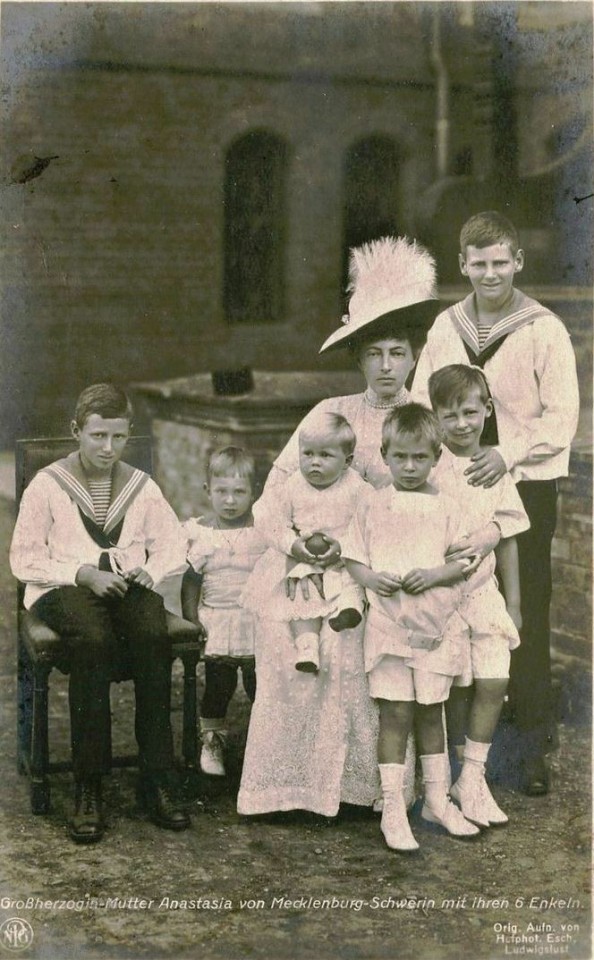
Grand Duchess Anastasia Mikhailovna Romanova,Grand Duchess of Mecklenburg-Schwerin with six of her grandsons :
•Prince Frederick of Denmark (the eldest boy in sailor top) the future King Frederick lX of Denmark,father of the present Queen of Denmark,Margarethe
•Prince Knud of Denmark (the older boy in sailor top)
•Prince Wilhelm of Prussia
•Prince Louis Ferdinand of Prussia who later married Princess Kira Kirillovna Romanova of Russia,daughter of Grand Duke Kirill Vladimirovich Romanov of Russia and Grand Duchess Viktoria Feodorovna Romanova of Russia.
•Prince Hubertus of Prussia
•Prince Friedrich Georg of Prussia.
1 note
·
View note
Text
Vladimirovichi Edit Emperor Nicholas I (1796-1855) = Princess Charlotte of Prussia (1798-1860) | +-- Emperor Alexander II (1818-1881) = Princess Marie of Hesse (1824-1880) | +-- Grand Duke Vladimir Alexandrovich (1847-1909) = Duchess Marie of Mecklenburg-Schwerin (1854-1920) | +-- Grand Duke Alexander Vladimirovich (1875-1877) | +-- Grand Duke Cyril Vladimirovich (1876-1938) | = Princess Victoria Melita of Edinburgh (1875-1936) | | | +-- Princess Maria Kirillovna (1907-1951) cr. Grand Duchess of Russia[citation needed] | | = Friedrich Karl, Prince of Leiningen (1898-1946) | | | +-- Princess Kira Kirillovna (1909-1967) cr. Grand Duchess of Russia[citation needed] | | = Louis Ferdinand, Prince of Prussia (1907-1994) | | | +-- Prince Vladimir Kirillovich (1917-1992) cr. Grand Duke of Russia[citation needed] | = Princess Leonida Bagration-Moukhransky (1914-2010) | | | +-- Grand Duchess Maria Vladimirovna[citation needed] (b. 1953) | = Prince Franz Wilhelm of Prussia (b. 1943)cr. Grand Duke of Russia div. | | | +-- Prince George of Prussia (b. 1981) cr. Grand Duke of Russia[citation needed] | +-- Grand Duke Boris Vladimirovich (1877-1943) | = Zinaida Rashevskaya (1898-1963) | +-- Grand Duke Andrei Vladimirovich (1879-1956) | = Mathilde Kschessinska (1872-1971) cr. Princess Romanovskya-Krassinskya | | | +-- Prince Vladimir Romanovsky-Krasinsky (1902-1974) | +-- Grand Duchess Elena Vladimirovna (1882-1957) = Prince Nicholas of Greece and Denmark (1872-1938)
3 notes
·
View notes
Text

Freidrich Franz Michael Wilhelm Nikolaus Franz-Joseph Ernst August Hans, Hereditary Grand Duke of Mecklenburg-Schwerin Christian Ludwig Ernst August Maximilian Johann Albrecht Adolf Friedrich, Duke of Mecklenburg-Schwerin Ernst August Christian Georg, Duke of Brunswick Georg Wilhelm Ernst August Friedrich Axel, Prince of Hanover
German vintage postcard, mailed in 1917 to Coburg
#historic#michael wilhelm nikolaus franz-joseph ernst#georg wilhelm ernst#photography#vintage#christian#sepia#coburg#ludwig ernst#photo#ernst#briefkaart#nikolaus#johann#prince#august#adolf#friedrich#1917#hanover#ansichtskarte#postcard#michael#albrecht#mailed#ludwig#grand#christian georg#mecklenburg#schwerin
5 notes
·
View notes
Text
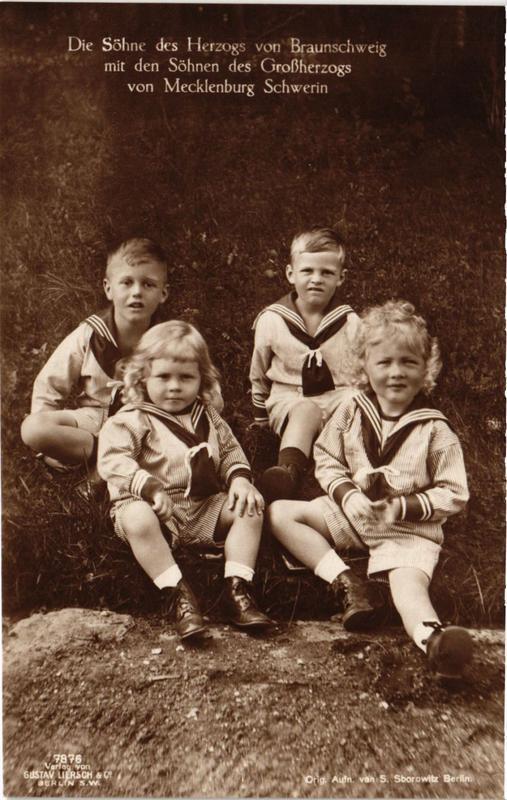
Ernst August, Hereditary Prince of Brunswick, Prince of Hanover Prince Georg Wilhelm Ernst August Friedrich Axel of Hanover Friedrich Franz, Hereditary Grand Duke of Mecklenburg-Schwerin Duke Christian Ludwig Ernst August Maximilian Johann Albrecht Adolf Friedrich of Mecklenburg-Schwerin
German vintage postcard
#christian ludwig ernst#christian#postkaart#axel#friedrich#friedrich axel#maximilian johann albrecht adolf friedrich#carte postale#franz#briefkaart#friedrich franz#georg#old#sepia#grand#wilhelm#mecklenburg#postkarte#vintage#johann#postal#duke#albrecht#brunswick#georg wilhelm ernst#photography#august#adolf#ernst#schwerin
2 notes
·
View notes
Text
when: royally fun facts
They may not be fun, but some of them are made-up. Made up facts are in italics.
Grand Duchess Anastasia Mikhailovna of Russia
(Karolina Augusta's great-great-grandmother)
Is the granddaughter of Tsar Nicholas I of Russia
Is the mother of Alexandrine, Queen Consort of Denmark
Is the mother of Frederick Francis IV, Grand Duke of Mecklenburg-Schwerin
Is the mother of Cecilie, Crown Princess of Germany
Following the death of her husband, had a illegitimate son with her personal secretary
Three of her brothers were murdered by the Bolsheviks during the Russian revolution
Princess Karola of Urach
(Karolina Augusta's great-grandmother)
Karola’s father, Wilhelm Karl, 2nd Duke of Urach, was briefly elected as the King of Lithuania in 1918.
Princess Karola of Urach was the first queen consort of Mecklenburg, and also the last Grand Duchess of Mecklenburg-Schwerin and of Mecklenburg-Strelitz.
Karola was the grand-niece of Empress Elisabeth ‘Sisi’ of Austria.
Karola was the half-niece of Queen Elisabeth of the Belgians.
Karola half-first cousins include Leopold III of Belgium, and Marie José, the last Queen Consort of Italy.
Karola and Mary of Teck, Queen of the United Kingdom, both descend from morganatic branches of the House of Württemberg. Karola and Mary were third cousins as great-great-granddaughters of Friedrich II Eugene, Duke of Württemberg.
Karola was a Roman Catholic and retained her faith following her marriage to Heinrich Ludwig, though their children were brought up in the Evangelical Lutheran Church of Mecklenburg.
Duchess Thyra of Mecklenburg-Schwerin
(Karolina Augusta's grandmother)
Thyra’s father, Grand Duke Friedrich Franz IV of Mecklenburg-Schwerin, was overthrown by her father-in-law, King Heinrich Ludwig of Mecklenburg
Thyra was the first Crown Princess of Mecklenburg (1939 - 1954)
Thyra was the second Queen of Mecklenburg (1954 - 1980)
Thyra was the niece of Alexandrine, Queen of Denmark (1912 - 1947)
Thyra was the first cousin of Frederik IX of Denmark (1947 - 1972)
Thyra was the niece of Cecilie, Crown Princess of Germany (1905 - 1951)
Thyra was the first cousin of Louis Ferdinand, Prince of Prussia (1951 - 1994)
Thyra was the niece of Marie Louise, Margravine of Baden (1928 - 1929)
Thyra was the first cousin of Berthold, Margrave of Baden (1929 - 1963), who married Princess Theodora of Greece and Denmark (the older sister of Prince Philip, Duke of Edinburgh)
Thyra was the niece of Ernest Augustus, Duke of Brunswick (1913 - 1918) and head of the House of Hannover (1923 - 1953)
Thyra was the first cousin of Ernst August, Hereditary Prince of Brunswick, Prince of Hanover (1953 - 1987)
Thyra was the first cousin of Frederica, Queen of Greece (1947 - 1964)
Princess Eleonora of Leiningen
(Karolina Augusta's mother)
Descends from all three children of Victoria of Saxe-Coburg-Saalfeld: Carl, 3rd Prince of Leiningen; Princess Feodora of Leiningen; and Queen Victoria of the United Kingdom.
Queen Karolina Augusta I of Mecklenburg
Is the first female ruler in Mecklenburg’s 900 year history.
Will be the final ruler from the House of Mecklenburg which will eventually bring an end to the House’s status as the longest still reigning house in European history.
Is descended from both Queen Victoria of the United Kingdom, and of King Christian IX of Denmark.
Has been the youngest monarch in the world since 1992.
Has 15 godparents:
HRH Princess Cecilie Auguste, Duchess of Ludwigslust (paternal aunt)
HRH Princess Marie Anastasia, Duchess of Grevesmühlen (paternal aunt)
HRH Princess Benedikte of Denmark (paternal second cousin once removed)
HRH Princess Alexandra of Hanover, Princess of Leiningen (maternal aunt-by-marriage)
HSH Princess Margarita of Hohenlohe-Oehringen, Princess of Leiningen (maternal aunt-by-marriage)
HM Silvia, Queen of Sweden (family friend)
HM Queen Beatrix of the Netherlands (paternal and maternal second cousin twice removed)
HRH Princess Astrid of Belgium, Archduchess of Austria-Este (paternal third cousin once removed)
HRH Prince Charles, Prince of Wales (paternal third cousin once removed and family friend)
HRH Prince Frederik, Crown Prince of Denmark (paternal third cousin)
HH Prince Harald of Denmark (paternal first cousin once removed)
HSH Prince Hermann Friedrich of Leiningen (maternal first cousin once removed)
HRH Prince Felipe, Prince of Asturias (paternal third cousin)
HH Borwin, Duke of Mecklenburg-Strelitz (distant cousin and family friend)
HSH Hans-Adam II of Liechtenstein (distant cousin and family friend)
0 notes
Text
where: other notable residences
These other notable residences will play a role, either big or small, in the story. Properties will be added as the story goes on with the first appearance of each residence linked as reference. Most of these residences never become official or country residences of characters in the story, but some do.
They are listed by order of appearance. Very, very mild spoilers below.

SCHLOSS LÜTZOW
Situated twenty minutes west of Schwerin, Schloss Lützow and its surrounding estate was purchased by Queen Eleonora in 2005 and converted into a hotel. Its other purpose is to act as additional accommodation for important guests of state and royal events at nearby Schweriner Schloss.

SCHLOSS RABEN STEINFELD
Located twenty minutes south-west of Schweriner Schloss, Schloss Raben Steinfeld was the summer house of the Grand Dukes and Duchesses, and later the dower house of the Grand Duchesses of Mecklenburg-Schwerin, during the latter half of the 19th century. After being largely neglected by King Heinrich Ludwig I and Queen Karola in favour of Schloss Wiligrad, it became the summer residence of Crown Prince Paul Friedrich and Crown Princess Thyra and their children after the end of the Second World War until Paul Friedrich became King in 1954. The Schloss is now used a additional accommodation for important guests of state and royal events at nearby Schweriner Schloss.

HERRENHAUS MALLIN
Located west of Neubrandenburg, Herrenhaus Mallin was abandoned in 1991 and has since decayed rapidly. Queen Karolina Augusta I purchased the building and estate in 2010 after the previous owners failed several times trying to raise the funds to restore the property. Restoration began in 2011 and was completed in 2014. The Herrenhaus is now a hotel.

SCHLOSS BASEDOW
Located in present day central Mecklenburg, Schloss Basedow and the surrounding village were purchased by Queen Eleonora from the pre-Soviet owners, the Hahn family. The Schloss was converted into a hotel. The Schloss and surrounding village are now owned by Queen Karolina Augusta I.

SCHLOSS HASENWINKEL
Located thirty minutes north-east of Schwerin, Schloss Hasenwinkel was purchased by King Wilhelm Franz I in 1991 and was later converted into a hotel.

SCHLOSS KARTLOW
Located in present day eastern Mecklenburg, the Schloss was purchased by King Wilhelm Franz I in 1991 and was later converted into a hotel.
0 notes
Text
where: country residences
Country residences are used by members of the Royal House and Family of Mecklenburg as their weekend or family residence. These residences are closed to the public, though the gardens and grounds may be accessible on special occasions. Country residences aren’t shared between members of the Royal House and Family.

SCHLOSS LUDWIGSLUST
Schloss Ludwigslust is the country residence of the monarch of Mecklenburg. It is currently occupied by Karolina Augusta I. The Schloss is surrounded by hundreds of acres of gardens, lakes, woods and fields, and is the favoured residence of Karolina Augusta I.

SCHLOSS WILIGRAD
Schloss Wiligrad was built for Duke Johann Albrecht and his first wife Duchess Elisabeth Sybille from 1896 to 1898. Their son, Heinrich Ludwig, grew up in the Schloss and it has remained a beloved home of the Royal Family. Schloss Wiligrad is commonly used by Dowager Queens due to its close proximity to Schwerin. The Schloss is currently occupied by Queen Eleonora.

JAGDSCHLOSS GELBENSANDE
This Jagdschloss, meaning Hunting Lodge, was built for Friedrich Franz III, Grand Duke of Mecklenburg-Schwerin between 1880 and 1895. The Grand Duke died two years after its completion. It was at this hunting lodge that his youngest daughter, Cecilie, became engaged to the Crown Prince of Germany and Prussia. The Jagdschloss is not currently occupied exclusively but is used by members of the Royal House and Family when carrying out duties in nearby Rostock and choose not to stay at the grander palace of Euphemiasberg.

SCHLOSS GÜLTZ
Schloss Gültz formerly belonged to the von Maltzahn family until the Soviets annexation of eastern Mecklenburg following the Second World War. The Schloss and its estate were purchased by King Wilhelm Franz I in 1991. Restoration of the property was completed after some delays in 2001. It is currently occupied by Cecilie Auguste and Michael, Duchess and Duke of Ludwigslust and their family.

SCHLOSS SCHLEMMIN
Schloss Schlemmin is situated in lands formerly occupied by the Soviets and remained in excellent condition during the occupation. The Schloss and the surrounding estate were purchased by Queen Eleonora in 1999. Since a light restoration and renovation, the property has been occupied by Albrecht Gustav and Veronica, Duke and Duchess of Bad Doberan and their children.

JAGDSCHLOSS DASCHOW
The Jagschloss was purchased by King Heinrich Ludwig I in 1947 after the previous owners moved out of the country. The hunting lodge has been continuously used by the Royal Family since then and is currently occupied by Heinrike Franziska, Duchess of Ratzeburg.

JAGDSCHLOSS FRIEDRICHSMOOR
The Jagdschloss Friedrichsmoor was built for Friedrich William, Duke of Mecklenburg-Schwerin in 1704 and has remained in the family’s possession ever since. The hunting lodge is currently the home to Princess Feodora and Prince Karl Emmeran of Liechtenstein and their children.

SCHLOSS GROSS PLASTEN
The Schloss was the property of the von Michael family until 1945. The Schloss and its estate were purchased by King Wilhelm Franz I in 1991 and following light restoration and renovation became the home of the late King’s aunt, Marie Elisabeth, Duchess of Parchim.

HERRENHAUS KITTENDORF
This Herrenhaus, meaning manor house, was built in 1766 for the von Oertzen family. The manor house became the property of the Soviet government from 1945. The Herrenhaus and its estate were purchased by Queen Eleonora in 1993 and following extensive restoration became the home of Ingrid Sophie, Duchess of Teterow in 2001.

SCHLOSS MARIHN
This Schloss was also in occupied Mecklenburg, close to Neustrelitz. The Schloss was purchased by Queen Eleonora in 1994 and following light restoration became the home of Prince Harald and Princess Helene of Denmark and their children.

JAGDSCHLOSS QUITZIN
Following the fall of the Soviets and the reunification of Mecklenburg, this Jagdschloss was returned to the previous owner’s family. It remained in their possession until 2006 when it was purchased by Karolina Augusta I. Since then is has been the home of Alexandrine Luise and Alexander, Duchess and Duke of Waren and their family.

JAGDSCHLOSS PRILLWITZ
This hunting lodge was bought by Karl II, Grand Duke of Mecklenburg-Strelitz in 1795. It was inherited by members of his family until it was finally inherited by Elisabeth, the mother of Adolf Friedrich VI, the last Grand Duke of Mecklenburg-Strelitz. When Elisabeth died in 1933, the property was purchased by King Heinrich Ludwig I. Today, it is occupied by Klaus Wilhelm, Duke of Mecklenburg-Schwerin and Havel.

SCHLOSS SCHORSSOW
The Schloss was the property of the Soviet government until 1990 when it became the property of King Wilhelm Franz I. After extensive restoration, the Schloss became the home of Elisabeth Mathilde, Duchess of Güstrow and her two sons and their families.

SCHLOSS VARCHENTIN
Schloss Varchentin was owned by the Soviet government from 1945 to 1990 when it was returned to the previous owner’s family, the von Grotes. The family was unable to fund the restoration of the Schloss and sold the property to Queen Eleonora in 2001. After an extensive restoration, the Schloss became the home of Marie Anastasia, Duchess of Grevesmühlen and her three sons and their families.

HERRENHAUS WENDORF
Located in western Mecklenburg, this manor house was purchased by King Paul Friedrich II in 1974. The Herrenhaus moved between family members until it was turned into a hotel in the mid 1990s. In 2012 it became the home of Karolina Augusta I’s cousin Prince Paul Ludwig and his wife Princess Evelyn.
0 notes
Text
where: schloss ludwigslust

Schloss Ludwigslust (Ludwigslust Palace) is the country residence of the reigning monarch of Mecklenburg. Located in town of the same name, Ludwigslust, forty minutes south of Schwerin, the first structure was built in 1724 as a hunting lodge for Duke Christian Ludwig of Mecklenburg-Schwerin (he would later become the Grand Duke of Mecklenburg-Schwerin). He loved the building and named it Ludwigslust (Ludwig’s Joy).
After Christian Ludwig’s son, Friedrich II, Grand Duke of Mecklenburg-Schwerin, moved the nation’s capital from Schwerin to Ludwigslust in 1764, a newer and grander residence was planned.
The present day Baroque Schloss was built between 1772 and 1776 and enjoys a large wooded park, containing a canal, several ponds and streams, a tea pavilion, a bell tower, a Roman Catholic Church, a Lutheran Church, grave sites and mausoleums, and several buildings which are used as accommodation for the extended family and members of the royal court. The original stables were converted into staff accommodation with new stables built deeper in the estate to afford greater privacy.
King Heinrich Ludwig II allowed his cousin, the deposed Friedrich Franz IV, Grand Duke of Mecklenburg-Schwerin, possession of Schloss Ludwigslust for the rest of his life, or for the rest of his wife, Alexandra’s life, should he died before her. The former Grand Duke died at Schweriner Schloss in November 1945 and his wife moved to Schloss Ludwigslust where she lived until her death in August 1963.
Since 1963, Schloss Ludwigslust has been the country residence of the monarch of Mecklenburg. It has been well loved by the monarchs that have lived there since 1963, Paul Friedrich II, Wilhelm Franz I and the current monarch Karolina Augusta I, were all said to have favoured Schloss Ludwigslust above all their other residences.
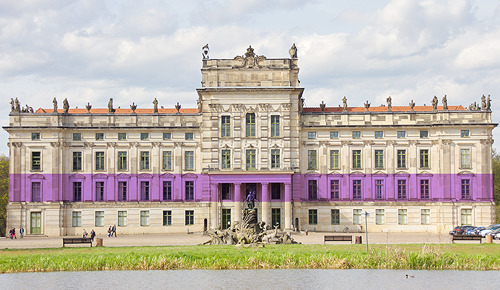
A closer look at the Schloss. The highlighted First Floor is laid out by the floor plan below.

click here for higher resolution.
The first floor layout (being the first floor above ground level). The front of the building is at the bottom of the plan. The red area are state rooms. The yellow areas are common areas. The pink area is for staff. The purple areas are the two principal apartments in the Schloss.
The Monarch’s Apartment takes up the East Wing, while the Consort’s Apartment occupies the West Wing. The semi-public rooms of the Apartments are the Monarch’s Antechamber, Receiving Room, Study, and Picture Gallery & Dining Room, and the Consort’s Antechamber, Receiving Room, Study, and Dining Room. In these rooms, the monarch, consort or other members of the royal family can host audiences, meetings, or lunches and dinners while the Court is at Schloss Ludwigslust.
The second floor contains more state rooms, such as the Marble Hall (with doors leading to the front balcony, directly above the Guard Hall), guest accommodation in the East Wing, and family accommodation in the West Wing.
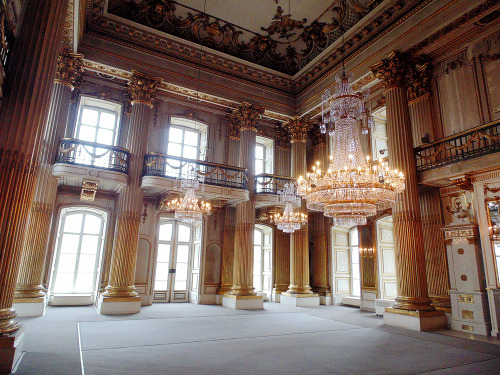
The Golden Hall of Schloss Ludwigslust (the largest rectangular room in the centre of the plan above). The doors lead out to a small balcony at the back of the building.
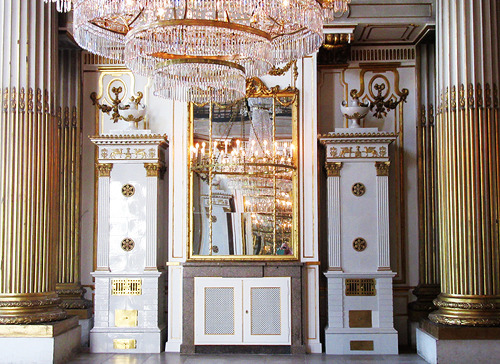
Details of the Golden Hall.

The West Wing Staircase.

The Schloss’s Tea Pavilion (No. 10 on the map below).

The Schweizerhaus (Swiss House, and No. 11 on the map below).

The plan of the Schlosspark (click here for the original photo in a higher resolution). The Schlosspark in the story is much larger and the town hasn’t been built so close to the Schloss.

The Cascade in front of the Schloss.

The Ludwigsluster Kanal. A favourite jogging route of Karolina Augusta.
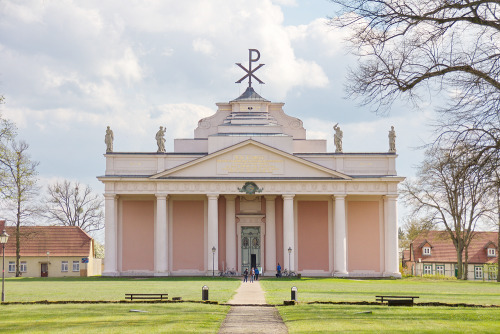
The Stadtkirche (City Church) of Ludwigslust. The kirche was opened to public worship in 1994, though it is only open to the public when the monarch is not in residence.
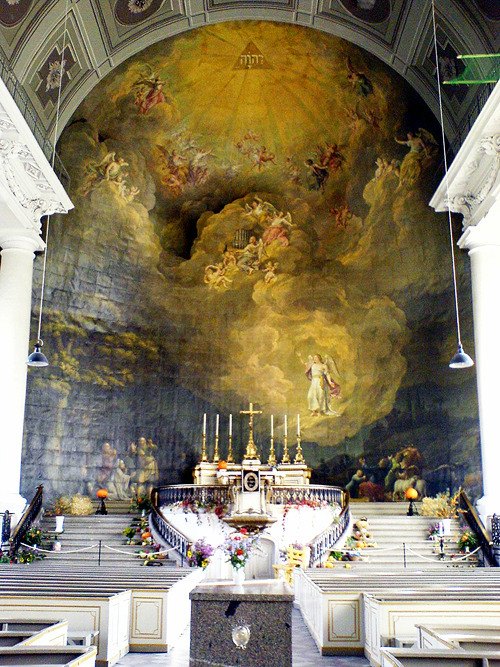
The altar of the Stadtkirche.

The back of the Stadtkirche’s interior. Traditionally, members of the royal family would view the service from the royal box. Nowadays, they sit at the front of the pews.
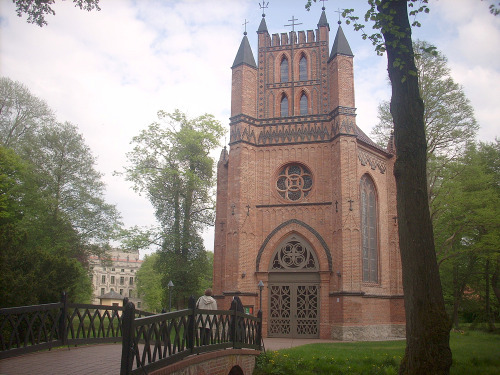
The Roman Catholic Church of St Helena and Andreas. Although the national religion and the vast majority of the population was (and is) protestant, Friedrich Franz I, Grand Duke, was sympathetic to Catholics and had the Church built for the small number of Catholics within the Royal Court. The Church became the favourite place of worship for Karola of Urach, the Roman Catholic wife of King Heinrich Ludwig I.

The church’s altar. Services continue to be held in the St Helena and Andreas Church every month.

The rear of the Schloss.
(Factual) Information taken from wikipedia.
Pictures taken from wikipedia commons.
0 notes
Text
where: schweriner schloss
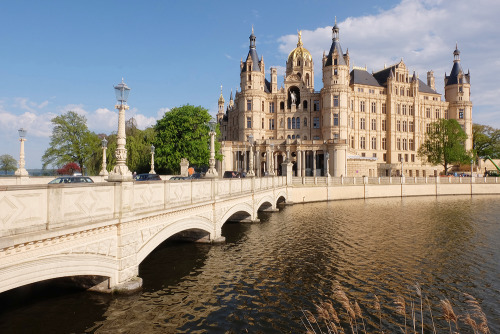
Schweriner Schloss (Schwerin Palace or Schwerin Castle) is the official residence and principal workplace of the reigning monarch of Mecklenburg. Located on an island in the Schweriner See in the nation’s capital, Schwerin, the current building was built between 1845 and 1857, though first records of a castle on the site date from 973.
In December 1913, a fire broke out and destroyed about a third of the building and thousands of priceless pieces of art. External repairs were completed in 1918, while internal repairs were completed in 1923.
The deposed Friedrich Franz IV, Grand Duke of Mecklenburg, and his wife Alexandra, Grand Duchess of Mecklenburg and Princess of Hanover, remained in possession of the Schloss until the Grand Duke’s death in November 1945, when the Grand Duchess moved to Schloss Ludwigslust.
During the last years of the Second World War, King Heinrich Ludwig I and his wife Queen Karola lived with the former Grand Duke and Duchess as the King and Queen were not permitted to live in their palace Euphemiasburg due to its proximity to the sea.
Since late 1945, it has been the official residence and principal workplace of the monarch.
The Schloss is open to the public from late July to early September each year.
Schweriner Schloss is a listed World Heritage Building and is known as the Neuschwanstein of the North.

Throne Room of the Monarch.

Ancestor Gallery, with the entrance to the Throne Room at the back.

The Winter Room, commonly used as a sitting room for guests.

The large spiral staircase, looking down.

The top of the large spiral staircase and the dome above it.

The main entrance to the Schloss, facing towards the front door and the city of Schwerin.

The view of the Schloss from the city.
Members of the Royal Family who were born at the Schloss:
HRH Princess Cecilie Auguste, Duchess of Ludwigslust, born 1947
HM King Wilhelm Franz I, Duke of Schwerin, born 1949
HRH Princess Alexandrine Luise, Duchess of Waren, born 1951
HRH Prince Albrecht Gustav, Duke of Bad Doberan, born 1953
HRH Princess Ingrid Sophie, Duchess of Teterow, born 1955
HM Queen Karolina Augusta I, Duchess of Rostock and Elde, born 1988
HRH Prince Klaus Wilhelm, Duke of Havel, born 1992
Members of the Royal Family who died at the Schloss:
HM King Heinrich Ludwig I, died 1954
HM Queen Karola, wife of Heinrich Ludwig I, died 1980
HM Queen Thyra, Duchess of Rostock wife of Paul Friedrich II, died 1981
HM King Paul Friedrich II, Duke of Rostock, died 1982

The city-facing portion of the Schloss lit up at night, with the statue of Niklot riding a horse in the centre.

The view of the Niklot statue from the back.

The Schloss and the Alter Garten. In the centre of the photo is the Schloss’s largest balcony, used by the Royal Family during important events. The building on the left is the Royal Opera, and the middle between that and the Schloss is the Royal Museum.

Here is the same view, from a slightly different angle. The Royal Opera and Royal Museum are in the right half of the photo. The Schwerin Cathedral is visible in the middle of the photo.

Part of the roof of the Schloss. Most of the roof is accessible by these causeways.

View of the Schloss from the Orangery.

View of the Orangery from the Schloss.

The interior of the Orangery, set up for when the Schloss is open to the public each summer.

A view of the Schloss from part of the Burggarten. The grey stone section in the centre forms part of the Schlosskirche. The row of windows directly above and to the right of the Kirche’s large windows, are of Karolina Augusta’s bedroom.

Schlosskirche (Palace’s Chapel) interior view from the aisle. The kirche is the private chapel of the Royal Family, but is not a prominent kirche in the family’s public life. Weddings and christenings are never held at the Schlosskirche.

The back and ceiling of the Schlosskirche.

A view of the Schloss from a different part of the Burggarten. The Schlosskirche is still visible on the right. The top row of windows completely visible in this photo are of Karolina Augusta’s Library and Adjutant’s Room. The floor below is of the Principle Guest Suite’s bedroom, ensuite, and drawing room.

Aerial view of the Schloss and garden. The floating meadow to the right of the main garden is open to the public year round. The main garden is only open to the public when the monarch is not in residence (most weekends and several weeks of the summer months). Note the balcony over the Schloss entrance in the lower right corner, and the Orangery in the lower left corner.

A closer view of the Schlossgarten, with a statue of Friedrich Franz II of Mecklenburg-Schwerin on horseback.

A view of part of the Burggarten and the small island (shown below on the map) on the south east corner of the Schlossinsel.

click here for higher resolution with more details.
Layout of the Schloss Island and the floorplan for the 1st Floor of the building. This level goes between the Mezzanine and 2nd Floor of the image below. The Orangery is at the top of the image. The bridge on the right leads to the Schlossgarten. The bridge at the bottom leads to the city. The Schloss is a six sided building around a central courtyard. The Red and Yellow areas are open to the public when the Schloss is open to visitors during each summer.

click here for higher resolution with more details.
Layout of a further four levels of Schweriner Schloss. The Red and Yellow areas are open to the public when the Schloss is open to visitors each summer.

View of the Schloss from the lakeside opposite during winter.

View of the Schloss from the lake. In the centre of the photo is the Orangery, to its right is the Schloss’s Grotto.
(Factual) Information taken from wikipedia.
Pictures taken from wikipedia commons.
Schweriner Schloss Layout from pinterest.
1 note
·
View note
Text
who: mecklenburgish line of succession
The line was succession to the Mecklenburgish throne was changed from agnatic primogeniture to male preference primogeniture on 1 January 1930 upon the descendants of Heinrich Ludwig I.
The line of succession was changed from male preference primogeniture to absolute primogeniture for the descendants of Wilhelm Franz I on 1 January 1990, male preference primogeniture continues for the rest of Heinrich Ludwig I’s descendants.
Conditions of eligibility until 2006
Legitimate descendant of Heinrich Ludwig I (legitimised children are not applicable)
Raised protestant
Marries with the consent of the Monarch
Conditions of eligibility from 2006
Legitimate descendant of Heinrich Ludwig I (legitimised children are not applicable)
Consent to marry is required for the first seven in line to remain eligible
Prior to 1982, all people in the line of succession had to make marriages to members of ruling royal houses, former ruling royal houses or noble families to remain in the line of succession.
LINE OF SUCCESSION ON 1 DECEMBER 2014
HM Heinrich Ludwig I (b. 1890 d. 1954) …..HM Paul Friedrich II (b. 1919 d. 1982) ……….HM King Wilhelm Franz I (b. 1949 d. 1992) ……………HM Queen Karolina Augusta I (b. 1988) ……………(1) HRH Prince Klaus Wilhelm, Duke of Havel and Mecklenburg-Schwerin (b. 1992) ……….(2) HRH Prince Albrecht Gustav, Duke of Bad Doberan (9. 1953) ……………(3) HRH Prince Paul Ludwig of Mecklenburg (b. 1983) ……………(4) HRH Prince Christian Franz of Mecklenburg (b. 1987) ……………(5) HRH Princess Marie Leopoldine of Mecklenburg (b. 1985) ……………(6) HRH Princess Marie Josefine of Mecklenburg (b. 1989) ……….(7) HRH Princess Heinrike Franziska, Duchess of Ratzeburg (b. 1940) ……….(8) HRH Princess Elisabeth Mathilde, Duchess of Güstrow (b. 1942) ……………(9) HSH Prince Ludwig of Hohenlohe-Langenburg (b. 1973) ………………..(10) HSH Princess Juliana of Hohenlohe-Langenburg (b. 2005) ………………..(11) HSH Princess Lucinda of Hohenlohe-Langenburg (b. 2006) ……………(12) HSH Prince Konstantin of Hohenlohe-Langenburg (b. 1976) ………………..(13) HSH Prince Rupprecht of Hohenlohe-Langenburg (b. 2012) ………………..(14) HSH Prince Samuel of Hohenlohe-Langenburg (b. 2014) ……….(15) HRH Princess Marie Anastasia, Duchess of Grevesmühlen (b. 1944) ……………(16) HH Prince Karl Viktor of Hesse-Kassel (b. 1973) ………………..(17) HH Prince Otto of Hesse-Kassel (b. 2005) ………………..(18) HH Princess Mafalda of Hesse-Kassel (b. 2008) ………………..(19) HH Princess Pauline of Hesse-Kassel (b. 2010) ……………(20) HH Prince Ernst Albert of Hesse-Kassel (b. 1974) ……………(21) HH Prince Nikolaus Emmanuel of Hesse-Kassel (b. 1975) ………………..(22) HH Prince Daniel of Hesse-Kassel (b. 2008) ………………..(23) HH Prince Peter of Hesse-Kassel (b. 2010) ………………..(24) HH Princess Milena of Hesse-Kassel (.b 2013) ……….(25) HRH Princess Cecilie Auguste, Duchess of Ludwigslust (b. 1947) ……………(26) HSH Prince Friedrich Magnus of Schwarzburg (b. 1977) ………………..(27) HSH Prince Bernhard of Schwarzburg (b. 2009) ………………..(28) HSH Prince Joachim of Schwarzburg (b. 2011) ………………..(29) HSH Princess Theresia of Schwarzburg (b. 2007) ………………..(30) HSH Princess Antoinette of Schwarzburg (b. 2013) ……………(31) HSH Princess Anne Therese of Schwarzburg (b. 1980) ……….(32) HRH Princess Alexandrine Luise, Duchess of Waren (b. 1951) ……………(33) HH Princess Ingeborg, Marchioness of Bowmont and Cessford (b. 1982) ……………(34) HH Princess Sigrid of Schleswig-Holstein-Sonderburg-Glücksburg (b. 1983) ……….HRH Princess Ingrid Sophie, Duchess of Teterow (b. 1955 d. 2012) …..(35) HRH Princess Marie Elisabeth, Duchess of Parchim (b. 1921) ……….(36) HH Prince Harald of Denmark (b. 1953) ……………(37) HH Prince Oskar of Denmark (b. 1983) ……………(38) HH Prince Axel of Denmark (b. 1985) ……………(39) HH Princess Louisa of Denmark (b. 1982) ……….(40) HH Princess Feodora of Liechtenstein (b. 1955) ……………(41) HSH Prince Adam Karl of Liechtenstein (b. 1986) ……………(42) HSH Prince Peter Gregor of Liechtenstein (b. 1991) ……………(43) HSH Princess Bernadette Sophia of Liechtenstein (b. 1984) ……………(44) HSH Princess Johanna Eleonore of Liechtenstein (b. 1988)
0 notes
Text
who: royal duchies of mecklenburg
Since 1930 various members of the Royal House of Mecklenburg have been awarded dukedoms similar to the current practice in Sweden.
The first two dukedoms were awarded to the children of King Heinrich Ludwig I on 1 January 1930 when the King changed the rules of succession to allow women to inherit. Since 1930, dukedoms have been awarded upon birth, with the exception of Heinrich Ludwig’s three eldest granddaughters who were born in London during WWII. The three princesses were retroactively granted their titles once word of their births had reached the King in Mecklenburg.
These titles are only nominal and non-hereditary, though they are transferrable to any spouse of the original holder of the title. The dukedoms are granted without rank but are placed above all other titles (except for monarchical titles and the crown princely title of the heir/ess apparent). Unlike Sweden, the monarch continues to use their dukedom title after ascending the throne.
Dukedoms’ names are taken from major cities and towns in Mecklenburg, along with significant landmarks.
Below is a list of dukedoms in the order they were granted:
Paul Friedrich II, Duke of Rostock, 1930-1982
Marie Elisabeth, Duchess of Parchim, 1930-present
Heinrike Franziska, Duchess of Ratzeburg, 1940-present
Elisabeth Mathilde, Duchess of Güstrow, 1942-present
Marie Anastasia, Duchess of Grevesmühlen, 1944-present
Cecilie Auguste, Duchess of Ludwigslust, 1947-present
Wilhelm Franz I, Duke of Schwerin, 1949-1992
Alexandrine Luise, Duchess of Waren, 1951-present
Albrecht Gustav, Duke of Bad Doberan, 1953-present
Ingrid Sophie, Duchess of Teterow, 1955-2012
Karolina Augusta I, Duchess of Elde, 1988-present
Karolina Augusta I, Duchess of Rostock, 1989-present
Klaus Wilhelm, Duke of Havel, 1992-present
The spouses of the above also held or hold the titles by virtue of their marriage:
Thyra of Mecklenburg-Schwerin, Duchess of Rostock, 1939-1981
Gorm of Denmark, Duke of Parchim, 1949-1991
Rupprecht of Hohenlohe-Langenburg, Duke of Güstrow, 1970-1978
Heinrich of Hesse-Kassel, Duke of Grevesmühlen, 1972-1999
Michael, Hereditary Prince of Schwarzburg, Duke of Ludwigslust, 1975-present
Alexander of Schleswig-Holstein, Duke of Waren, 1980-present
Veronica Doncaster, Duchess of Bad Doberan, 1982-present
Eleonora of Leiningen, Duchess of Schwerin, 1985-present
While there are no rules regarding who can and cannot be awarded dukedoms, it is the intention for the titles to be limited to the children of the monarch and the children of the heir or heiress apparent.
0 notes